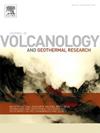南极洲布兰斯菲尔德海峡欺骗岛热液蚀变火山碎屑沉积物的岩石物理性质
IF 2.3
3区 地球科学
Q2 GEOSCIENCES, MULTIDISCIPLINARY
Journal of Volcanology and Geothermal Research
Pub Date : 2025-06-17
DOI:10.1016/j.jvolgeores.2025.108399
引用次数: 0
摘要
欺骗岛是一座复合火山,位于南设得兰群岛和南极半岛之间的布兰斯菲尔德海峡。火山是由火山口形成事件定义的,而形成岛屿的岩石——从玄武岩到粗面英安岩——流纹岩的组成范围——通常被分为前火山口、新火山口和后火山口。在这里,我们提供了岩石物理特性(体积密度、孔隙度、纵波速度、渗透率、热特性、杨氏模量和单轴抗压强度),用于研究破火山口前、新火山口和火山口后火山活动中具有代表性的柱状凝灰岩(火山碎屑密度流和碎屑沉积)。我们发现干容重变化范围为~ 982 ~ ~ 1813 kg·m−3,连通孔隙度变化范围为0.30 ~ 0.62,纵波速度变化范围为~ 0.3 ~ ~ 1 km·s−1,渗透率变化范围为~ 10 ~ 15 ~ ~ 10 ~ 11 m2,导热系数变化范围为~ 0.3 ~ ~ 0.65 W·m−1·K−1,热扩散系数变化范围为~ 0.35 ~ ~ 0.25 mm2·s−1,比热容变化范围为~ 0.8 ~ ~ 1.3 J·kg−1·K−1,杨氏模量变化范围为~ 1 ~ ~ 9 GPa,单轴抗压强度变化范围为~ 1 ~ ~ 25 MPa。我们的数据表明,纵波速度、杨氏模量、单轴抗压强度、导热系数和热扩散系数随孔隙度的增加而降低,渗透率增加,比热容不随孔隙度的增加而系统变化。我们还发现,与火山碎屑密度流凝灰岩相比,落屑凝灰岩更多孔,因此具有更低的纵波速度、杨氏模量、单轴抗压强度、导热系数和热扩散系数,但渗透率更高。我们的数据揭示了欺骗岛石柱凝灰岩的岩石物理性质的非均质性,并且与冰岛Surtsey火山和加拿大裂解山石柱凝灰岩的岩石物理性质很好地吻合。渗透率、导热系数和单轴抗压强度的微尺度模型可以帮助我们深入了解控制柱状凝灰岩岩石物理性质的微尺度因素,并且可以在缺乏数据或无法进行实验室实验的情况下帮助预测其岩石物理性质。使用我们实验室数据的大规模流体力学模型提供了欺骗岛在深度注入流体后的预期地表位移范围,并强调了为火山建模选择合适的岩石属性输入参数的重要性。本文章由计算机程序翻译,如有差异,请以英文原文为准。
Petrophysical properties of hydrothermally-altered pyroclastic deposits from Deception Island (Bransfield Strait, Antarctica)
Deception Island is a composite volcano located in the Bransfield Strait, between the South Shetland Islands and the Antarctic Peninsula. The volcano is defined by a caldera-forming event, and the rocks forming the island—which range in composition from basalts to trachydacites-rhyolites—are typically classified as either pre-, syn-, or post-caldera. Here, we provide petrophysical properties (bulk density, porosity, P-wave velocity, permeability, thermal properties, Young's modulus, and uniaxial compressive strength) for representative lapilli tuffs (pyroclastic density current and fall deposits) from the pre-, syn-, and post-caldera volcanic activity. We find that dry bulk density varies from ∼982 to ∼1813 kg·m−3, connected porosity varies from 0.30 to 0.62, P-wave velocity varies from ∼0.3 to ∼1 km·s−1, permeability varies from ∼10−15 to ∼10−11 m2, thermal conductivity varies from ∼0.3 to ∼0.65 W·m−1·K−1, thermal diffusivity varies from ∼0.35 to ∼0.25 mm2·s−1, specific heat capacity varies from ∼0.8 to ∼1.3 J·kg−1·K−1, Young's modulus varies from ∼1 to ∼9 GPa, and that uniaxial compressive strength varies from ∼1 to ∼25 MPa. Our data show that P-wave velocity, Young's modulus, uniaxial compressive strength, thermal conductivity, and thermal diffusivity decrease, permeability increases, and specific heat capacity does not change systematically as a function of increasing porosity. We also find that the fall tuffs are more porous than the pyroclastic density current tuffs, and therefore have a lower P-wave velocity, Young's modulus, uniaxial compressive strength, thermal conductivity, and thermal diffusivity, but a higher permeability. Our data expose the heterogeneity of the petrophysical properties of the lapilli tuffs at Deception Island, and are in good agreement with those for similar lapilli tuffs from Surtsey volcano (Iceland) and Cracked Mountain (Canada). Microscale models for permeability, thermal conductivity, and uniaxial compressive strength provide insight into the microscale factors controlling the petrophysical properties of the lapilli tuffs, and can be used to help predict their petrophysical properties when data are absent or laboratory experiments are not possible. Large-scale hydromechanical models that use our laboratory data provide the range of expected surface displacement at Deception Island following fluid injection at depth, and highlight the importance of choosing appropriate rock property input parameters for volcano modelling.
求助全文
通过发布文献求助,成功后即可免费获取论文全文。
去求助
来源期刊
CiteScore
5.90
自引率
13.80%
发文量
183
审稿时长
19.7 weeks
期刊介绍:
An international research journal with focus on volcanic and geothermal processes and their impact on the environment and society.
Submission of papers covering the following aspects of volcanology and geothermal research are encouraged:
(1) Geological aspects of volcanic systems: volcano stratigraphy, structure and tectonic influence; eruptive history; evolution of volcanic landforms; eruption style and progress; dispersal patterns of lava and ash; analysis of real-time eruption observations.
(2) Geochemical and petrological aspects of volcanic rocks: magma genesis and evolution; crystallization; volatile compositions, solubility, and degassing; volcanic petrography and textural analysis.
(3) Hydrology, geochemistry and measurement of volcanic and hydrothermal fluids: volcanic gas emissions; fumaroles and springs; crater lakes; hydrothermal mineralization.
(4) Geophysical aspects of volcanic systems: physical properties of volcanic rocks and magmas; heat flow studies; volcano seismology, geodesy and remote sensing.
(5) Computational modeling and experimental simulation of magmatic and hydrothermal processes: eruption dynamics; magma transport and storage; plume dynamics and ash dispersal; lava flow dynamics; hydrothermal fluid flow; thermodynamics of aqueous fluids and melts.
(6) Volcano hazard and risk research: hazard zonation methodology, development of forecasting tools; assessment techniques for vulnerability and impact.

 求助内容:
求助内容: 应助结果提醒方式:
应助结果提醒方式:


